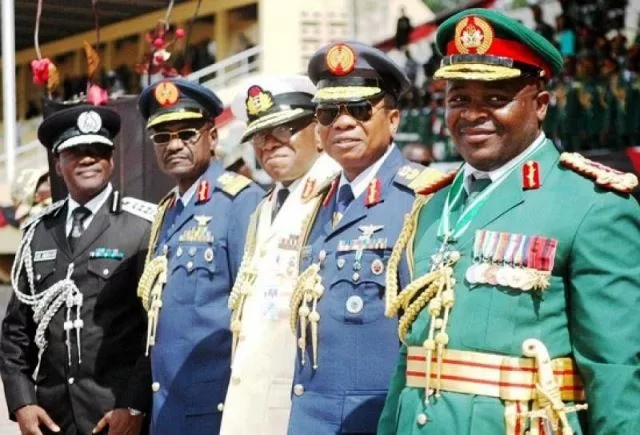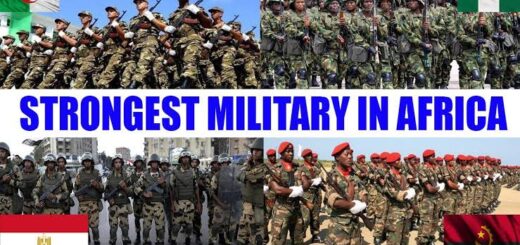Full List of Military and Paramilitary Ranks in Nigeria
In this post, we will list out all the military and paramilitary ranks in Nigeria. We will also provide the military ranks and its equivalent in police and civil service in Nigeria.

In Nigeria, the military and paramilitary forces play a crucial role in ensuring national security, maintaining law and order, and safeguarding the country’s territorial integrity. These organizations are structured hierarchically, with a well-defined system of ranks and titles that denote authority, responsibility, and experience. The Nigerian Armed Forces comprise the Nigerian Army, Nigerian Navy, and Nigerian Air Force, while paramilitary organizations such as the Nigeria Police Force, Nigeria Security and Civil Defence Corps (NSCDC), and Nigerian Immigration Service also have their own rank structures.
MILITARY RANKS IN NIGERIA
The military is a well-respected armed institution in Nigeria. There are three branches that make up this military: the Army, the Navy, and the Air Force. The rank structure of the Nigerian military are comparable to one another. There are more than 13 ranks in the Army, Navy and Air Force. This is because in each military branch, there are Commissioned and Non-commissioned officers.
Below is a table showing the various ranks and their equivalent in the Nigerian military
| Nigerian Army Ranks | Nigerian Navy Ranks | Nigerian Air Force Ranks |
|---|---|---|
| Recruit | Trainee | Trainee |
| Private | Ordinary Seaman | Aircraftman / woman |
| Lance Corporal | Seaman | Lance Corporal |
| Corporal | Able Seaman | Corporal |
| Sergeant | Leading Seaman | Sergeant |
| Staff Sergeant | Petty Officer | Flight Sergeant |
| Warrant Officer | Warrant Officer | Warrant Officer |
| Master Warrant Officer | Master Warrant Officer | Master Warrant Officer |
| Army Warrant Officer | Navy Warrant Officer | Air Warrant Officer |
| Second Lieutenant | Midshipman | Pilot Officer |
| Lieutenant | Sub-Lieutenant | Flying Officer |
| Captain | Lieutenant | Flight Lieutenant |
| Major | Lieutenant Commander | Squadron Leader |
| Lieutenant Colonel | Commander | Wing Commander |
| Colonel | Captain | Group Captain |
| Brigadier General | Commodore | Air Commodore |
| Major General | Rear Admiral | Air Vice-Marshal |
| Lieutenant General | Vice-Admiral | Air Marshal |
| General | Admiral | Air Chief Marshal |
| Field Marshal | Admiral of the Fleet | Marshal of the Air Force |
PARAMILITARY RANKS IN NIGERIA
Nigeria boasts a complex and diverse landscape of paramilitary organizations, each with its unique set of roles, responsibilities, and ranks. These paramilitary forces play a crucial role in maintaining national security, enforcing laws, and supporting various government initiatives. From the renowned Nigerian Police Force to the Nigeria Security and Civil Defence Corps (NSCDC) and other agencies, the country’s paramilitary ranks are a reflection of its commitment to safeguarding its citizens and preserving law and order
Here’s a table showing the various ranks in different Nigerian paramilitary organizations and their equivalent.
| Nigeria Police Force | Nigeria Customs Service | Nigeria Immigration Service | Nigeria Federal Road Safety Corps | Nigeria Civil Defense Corps |
|---|---|---|---|---|
| Inspector General | Comptroller General (C.G.C) | Comptroller General (C.G.I) | Corps Marshal | Commandant General (CG) |
| Deputy Inspector-General | Deputy Comptroller General (DCGC) | Deputy Comptroller General (DCGI) | Assistant Corps Marshal | Deputy Commandant General (DCG) |
| Assistant Inspector-General | Assistant Comptroller General (ACGC) | Assistant Comptroller General (ACGI) | Deputy Corps Marshal | Assistant Commandant General (ACG) |
| Commissioner of Police | Comptroller (C.C) | Comptroller (C.I) | Corps Commander | Chief Commander (CC) |
| Deputy Commissioner of Police | Deputy Comptroller (DCC) | Deputy Comptroller (DCI) | Assistant Corps Commander | Assistant Commander (AC) |
| Assistant Commissioner of Police | Assistant Comptroller (ACC) | Assistant Comptroller (ACI) | ACM (Assistant Corps Marshal) | Deputy Commander (DC) |
| Chief Superintendent of Police | Chief Superintendent (CSC) | Chief Superintendent (CSI) | DCM (Deputy Corps Marshal) | Chief Superintendent Cadre (CSC) |
| Superintendent of Police | Superintendent (SC) | Superintendent (SI) | CM (Corps Marshal) | Superintendent Cadre (SC) |
| Deputy Superintendent of Police | Deputy Superintendent (DS) | Deputy Superintendent (DS) | ACM (Assistant Corps Marshal) | Deputy Superintendent Cadre (DSC) |
| Assistant Superintendent of Police | Assistant Superintendent of Customs I (ASC) | Assistant Superintendent I (ASI) | ACM (Assistant Corps Marshal) | Superintendent Cadre (SC) |
| Inspector of Police | Assistant Superintendent of Customs II (ASCII) | Assistant Superintendent II (ASII) | DCM (Deputy Corps Marshal) | Chief Superintendent Cadre (CSC) |
| Sergeant Major | Senior Inspector of Custom (SIC) | Senior Inspector of Immigration (SII) | CRMA (Chief Road Marshal Assistant) | Assistant Commandant General (ACG) |
| Sergeant | Assistant Inspector of Custom (AIC) | Assistant Inspector of Immigration (AII) | MI-III (Marshal Inspector III) | Deputy Commandant General (DCG) |
| Corporal | Senior Customs Assistant (SCA) | Immigration Assistant (IA) | MI-II (Marshal Inspector II) | Commandant General (CG) |
| Lance | Custom Assistant (CA) | Passport Officers | MI-I (Marshal Inspector I) | |
| Constable | SMI (Senior Marshal Inspector) |
HOW THE NIGERIAN MILITARY COMPARE TO OTHER MILITARIES
The Nigerian military has preserved its 35th position in the global military ranking in 2025. Egypt, was ranked 12th most powerful military in the world and the first in Africa. This ranking comprised of 142 countries assessed for the annual ranking in the previous year.
The Nigerian military are comparable to those of other Commonwealth nations. Nigerian military officers use rank insignia that are remarkably similar to those worn by the British Armed Forces. This is probably due to Nigeria’s previous status as a British colony.
The Nigerian military’s rank system is remarkably similar to the American military’s. Additionally, they have non-commissioned officers with the ranks of (private, corporal, and sergeant), senior warrant officers, and officers in control of everything from a platoon to an entire battalion.
The organisation also said Nigeria has a total of 140 aircraft, 14 interceptors, 15 attack helicopters, 26 training aircraft, and six special mission aircraft among others. On land, the Nigerian military is believed to have 376 tanks, 2,019 armoured vehicles; 44 self-propelled artillery; 349 towed artillery; mine warfare, two; and 47 rocket projectors.
It claimed while the Nigerian Navy had a total of 133 assets, one frigate, and 109 patrol vessels, the military branch, however, had no aircraft and helicopter carriers, destroyers, corvettes, and submarines.
THE HIGHEST AND LOWEST MILITARY RANKS IN NIGERIA
The Chief of Defense Staff isn’t a rank but the highest office in the military of the democratic government in Nigeria. The highest rank in the Nigerian military today under the civilian dispensation is the General who occupies the office of The Chief of Defense Staff. He is in charge of the Nigerian Armed Forces’ overall management and leadership. He is directly responsible to Nigeria’s President, who also serves as the military’s commander-in-chief.
A General is the Nigerian Army’s second highest rank. A general’s insignia consists of an eagle, two stars, and a baton and sword arranged vertically. The Field Marshall, the highest rank in the military, which is unattainable since we don’t run a military regime in the country. The Private is the lowest rank in the Nigerian military, followed by Lance Corporal and Corporal.
CONCLUSION
All the military and paramilitary ranks in Nigeria underscores the hierarchical structure that governs the country’s armed forces and security agencies. These ranks are not merely symbols of authority but also reflect the dedication, discipline, and commitment of individuals who serve to protect the nation. As Nigeria continues to face various security challenges, the adherence to these rank structures is crucial for maintaining order and ensuring effective coordination among the military and paramilitary organizations. These ranks, steeped in tradition and responsibility, serve as a testament to the nation’s resolve to safeguard its sovereignty and the well-being of its citizens.
